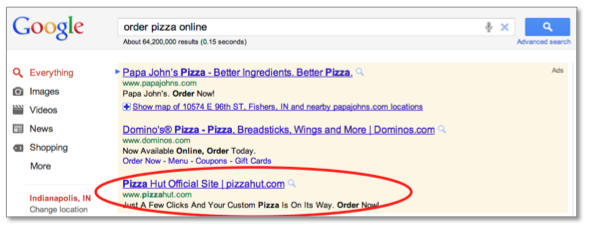It’s 3:15, school just let out, my buddies and I are prepared to set out on an extremely important voyage. A voyage only the bravest of men can possibly endure. With treasure map in hand, we set out…
This was myself as a youngster. After school, my mom would often surprise my friends and I with a map that led to hidden treasure. The treasure usually consisted of a plate piled high with PB&Js, cut into triangles of course. Who could turn down a plate stacked with peanut butter and jelly sandwiches!? Not my friends and I at the time, that’s for sure.
Perhaps this is the reason why I’ve come to appreciate a good map. A roadmap, treasure map, whatever kind it may be; maps help us get from point A to point B. The following will be no exception. I will show you how to perform a successful landing page audit using this roadmap. As PPC practitioners, it is important to consider every aspect of the marketing funnel, even after the click.
Landing pages are a crucial element of any paid search campaign because they can make or break your efforts. If your landing pages are not doing their job correctly, every click becomes wasted money. Furthermore, you will also end up paying more per click because of the negative toll it takes on your Quality Scores. This is why it is important to have all your ducks in a row. Having said that, the following is one way in which you can go about conducting a thorough landing page audit.
Reconnaissance
In order to get started, some reconnaissance is needed. Based upon the keywords you are bidding on, you will want to analyze your competitive landscape. You can do this easily by typing your keywords into Google and scanning the SERP. Who are your competitors? What are your competitors doing on their sites? How can I get the upper hand? In the case of the example above, the SERP reveals that Pizza Hut, Papa John’s, and Domino’s are all competing. Don’t hesitate to take a look at your competitor’s landing pages and look for ideas. This can be particularly beneficial for smaller companies trying to brand their landing pages with a professional look and competitive edge. Once you’ve completed your reconnaissance and gained some good insights, the next step is analyzing your own page.
What To Look For
Now that you have a good sense for what your competitors are doing, it’s time to evaluate your own page for areas of improvement. There are many helpful resources out there that talk about landing page best practices, so keep that in mind, as this is not a perfect list. Having said that, here are some things you will want to look for when scrutinizing your own landing pages:
1. Is your headline visible and relevant?
Giving your visitors a good first impression is crucial. Having a visible and relevant title will help your visitors to easily recognize what the page is about. In addition, your headline should also address the visitor’s reason for clicking your ad to begin with. Try placing your keywords in the title to confirm that they have landed in the right place.
2. Is your landing page copy clear and concise?
Keep your copy short, sweet, and to the point. Typically, people in the buying process are in a rapid-fire state of mind, so it is important to only highlight the key benefits of your product/service. The best way to achieve this is utilizing bulleted points to convey your information, as opposed to lengthy paragraphs.
3. Does your call-to-action stand out from the rest of the page?
This is one of the most crucial elements on your page. Basically, this should act as a second attention-grabber that indicates what your visitors should do next. Although results tend to vary, you might try testing emotion-driven vs. benefit-driven calls-to-action in order to see which work the best.
4. Is your page aesthetically pleasing?
The layout and design of your landing page is important because it can make or break a user’s experience. It should lend itself to a clear and simple recognition of the key marketing message in order to avoid confusion. Be sure not to go overboard with additional elements, such as images and widgets, which will only end up distracting your visitors from achieving what you want them to achieve.
5. Is your conversion form brief and strategically located?
In most cases, people tend to scan landing pages from left to right. This is why it can be largely beneficial to place your conversion form on the right side of the page. By strategically positioning your form, you can add more control to the conversion process because then it becomes one of the last things a visitor sees on your page. Conversion forms should also be very minimalistic. In other words, only ask for the information that is required to pursue that lead/conversion. Unless you have an Ecommerce site that requires payment information, a name, phone number and/or address can typically suffice.
6. Is your important material above the page fold?
As I mentioned earlier, buyers are often in a rapid-fire state of mind when browsing the web. As a rule of thumb, you want to think about your landing pages in the sense that there is no scroll bar. Your entire marketing message needs to be summed up above the fold because this will always be visible to your potential customers from first click.
7. Have you included indications of trust/authority?
When people visit your site, they want to feel like they’re safe and in good hands. Including symbols of security and trust are good ways to help your potential customers feel this way. These provide reassurance that their information will be treated with care, such as a “Safe & Secure Checkout” badge for example.
8. Are you keeping Quality Score in mind?
Quality Score is important to consider, not only because it effects how much you pay for each click, but also because it gauges the relevancy between your ads, landing pages and keywords. Therefore, you need to ensure that your keywords are included on the landing page itself. You also need to consider your page load times, because it will have a negative effect on QS as well. To avoid this, stay away from excessive animation and Flash programming.
9. Would you interact with your landing page?
This is the ultimate test! Just ask yourself if you would enjoy visiting a site like yours, filling out the form, and interacting where necessary? If the answer is “No” to any of those, you should probably consider going back to the drawing board.
Take Action
Now that you’ve done all this awesome research and developed some new ideas, it’s time to implement these changes on your landing pages. However, as PPC account managers, we’re not always blessed with the ability to implement these changes directly (and if you do, I’m jealous!). This is why it becomes important to realize that sometimes this is simply out of your control. On the other hand, there is no reason why you can’t recommend these suggestions to your client for consideration. From there, they might be able to send your recommendations off to one of their teams to implement for you.
Hopefully at this point, you’re not thinking you’re exempt from a good landing page audit. Something can always be changed and improved upon. It is my hope that all of you are now equipped with a better understanding of how to go about your own landing page audit. Are there other things you tend to look for when going about this process? I would welcome any and all of your feedback below!




